How to Install the Back Seat Covers on a 2019 Camray
DIY Seat Cover Installation to Spruce up Your Car
Make your car's interior look fresh and new with some seat covers
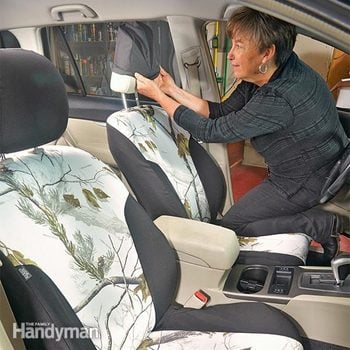 Family Handyman
Family Handyman
Are your car seats hopelessly stained or torn—or just plain ugly? Learn how to order and install replacement seat covers for both back and front seats.
You might also like: TBD
- Time
- Complexity
- Cost
- A full day
- Beginner
- Varies
Seat cover options
Whether you fill your vehicle with construction materials, haul kids and grandkids around or just spill lots of coffee, you know how easy it is for factory seat covers to get grungy. If they're beyond rescuing with an upholstery cleaner and you want to spruce up your vehicle's interior, you have only three options: Pay a professional automotive upholsterer to reupholster your seats (well over $1,000), buy used seats from a junkyard, or buy and install seat covers yourself.
Aftermarket seat covers cost as little as $50 per seat for a universal-fit style or about $150 per seat for top-of-the- line custom-fit covers. We'll show you how to order and install custom-fit seat covers. The installation is similar across makes and models. The job takes about two hours for front and rear seats. The only tools you'll need are a wire coat hanger and some tape to fish the straps under plastic trim pieces (if equipped). Everything else is included with the seat covers.
How to buy seat covers
Seat covers come in two styles: universal and custom-fit. You can buy universal seat covers right off the shelf at an auto parts store or order them online. Custom-fit seat covers must be ordered to fit your exact year, make, model and seat style. They're far more expensive than universal-fit seat covers. But they fit like a glove, stay put when you slide in and out, and are more comfortable. Plus, custom-fit seat covers include breakaway stitching so the air bag can deploy properly if your vehicle has side bolster air bags.
To get around the air bag issue and keep costs down, universal seat covers simply eliminate the fabric that would normally cover the seat air bags. Then, to reduce slipping, the manufacturers coat the underside of the fabric with an anti-skid rubber. That makes them a bit more uncomfortable to sit on for long periods. And they will inevitably slip out of place and wrinkle because they're not an exact fit for your seats.
For some strange reason we don't understand, officially licensed designer camouflage and sports patterns are the most popular seat cover fabrics these days. Since the fabric designers get a royalty on every sale, you'll pay more for those patterns. If you want to keep the cost down, skip the trendy camo and sports fabrics and choose a solid color.
If you order custom-fit seat covers, you'll have the option of also ordering matching armrest and headrest covers, console covers, seat back storage and map pockets.
Buy custom-fit and universal seat covers from retail and online auto parts stores, or directly from the manufacturer. We bought the custom-fit seat covers for this 2010 Subaru Outback at nwseatcovers.com. We bucked up and picked the trendy Bill Jordan Realtree AP Snow camo pattern and added headrest covers. The front seat covers cost $341 and the rears, $331. Here's how they install.
When You Install New Seat Covers
NOTE: We couldn't show you the trim disconnect and seat cover attachment points with the seat still in the vehicle. So we bought a junkyard Subaru seat to show how everything fits together. You don't have to remove the seats from the vehicle to install new seat covers. And since most seats are made the same way, these instructions will work with the majority of makes and models. However, if the seat cover manufacturers' instructions differ from ours, follow theirs instead.
Start with the front seat covers
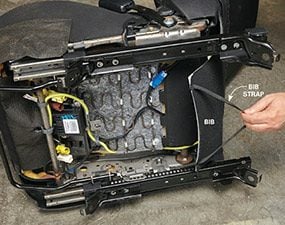
Photo 1: Release the bib panel
Follow the bib panel straps and unclip them from the springs or pull the elastic straps out from under the springs. Then lift the bib panel up to access the gap between the back and the bottom cushion.

Photo 2: Thread the straps through the gap
Push the bottom cushion straps through the gap between the seat back and the bottom cushion. Then pull the straps completely through until the seat cover is taut.
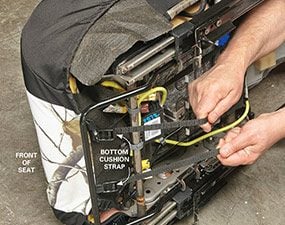
Photo 3: Buckle the seat cushion straps
Route the bottom cushion straps toward the front of the seat, making sure the straps don't interfere with the seat adjuster mechanism. Thread the strap into the buckle and cinch it tight to remove wrinkles in the seat cover.
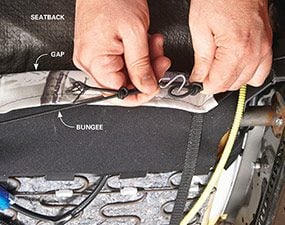
Photo 4: Tighten and connect the bungee cords
Pull the bungee cords to cinch the skirt on the bottom seat cover. Then connect the ends using the supplied S-hook.
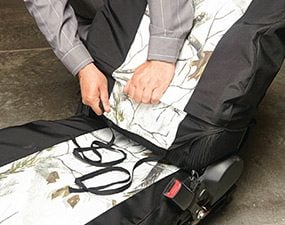
Photo 5: Install the seatback cover
Pull the cover down until it reaches the side bolsters (cushions). Then compress the bolster while you pull the fabric down to the bottom.

Photo 6: Install the headrest covers
Stretch the elastic edges around the headrest and pull it down. Tug at the cover fabric until it fits smoothly on the contour of the headrest.
The bottom seat cushion covers usually attach to the seat with straps, buckles and S-hooks. You'll have to thread bottom cushion straps through the gap between the seat back and the bottom cushions (where the back reclines). That's easy in older vehicles. But the gap in newer vehicles is usually covered with a "bib" panel. Don't worry. The bib is easy to disconnect. It's connected to the seat springs with either clips or an elastic strap. Just reach under the seat and disconnect the straps (Photo 1). Then lift the bib to access the gap.
Next, fit the seat cover onto the bottom cushion and thread the rear straps through the gap (Photo 2). Route the straps toward the front buckles and tighten (Photo 3). Then connect the bungee cords (Photo 4). Tuck the puckered seat cover "skirt" behind the plastic trim panels (if equipped).
Remove the headrests. Then slide the cover over the seat back cushion (Photo 5). Push the bottom straps through the gap and into the buckles just like you did on the bottom cushion (refer to Photo 3). Reconnect the bib panel and pull down on the rear portion of the seat back cover to remove wrinkles. Then stick the hook-loop edge to the bib to secure it. Stretch the headrest covers onto the headrest (Photo 6) and reinstall them on the seats.
Then move to the backseats
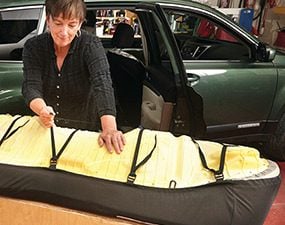
Photo 7: Install rear bench seat cover
Fit the cover onto the bench seat and thread the straps into the buckles. Tighten until snug. Check the fit and adjust. Then tighten the buckles, secure the bungee cords and connect the remaining straps to the springs with S-hooks.
If your vehicle has 60/40 rear bench seats, remove the bottom cushion first. If you have bucket seats in the rear, install them just like you did on the front seats. To remove a bench seat bottom cushion, run your hand along the front edge to locate the latch points. Try jerking straight up at the latch points. If the cushion doesn't release, push it straight back as you lift up to release it from the hook latches. Then remove the entire bottom cushion from the vehicle and set it on a bench. Install the bottom cushion seat cover with straps and S-hooks (Photo 7). Remove the rear headrests and slide the rear seat back covers onto the rear seats. Secure with the attached hook-and-loop fasteners. Add headrest covers and replace the headrests. You're done.
Add a Bun Warmer and Lumbar Support
If your vehicle didn't come with seat heaters, now's the time to add them. Add-on electric seat heaters fit between your existing seat cushions and the new seat covers and secure with elastic bands and straps. The seat heater control connects to a cigarette lighter or power outlet. The model we show here (the ProHeat pad and controller; about $85 from nwseatcovers.com) has an adjustable heat setting and automatic shutoff to prevent battery drain (in case you forget to turn it off). And, if you want lumbar support, slide this unit (about $70 at nwseatcovers.com) under the seat back cover before strapping it in place. Route the pump and tube out to the side. Once the seat covers are fully installed, adjust the firmness with the pump.
Required Materials for this Project
Avoid last-minute shopping trips by having all your materials ready ahead of time. Here's a list.
Similar Projects
How to Install the Back Seat Covers on a 2019 Camray
Source: https://www.familyhandyman.com/project/spruce-up-your-car-how-to-install-seat-covers/
0 Response to "How to Install the Back Seat Covers on a 2019 Camray"
Post a Comment